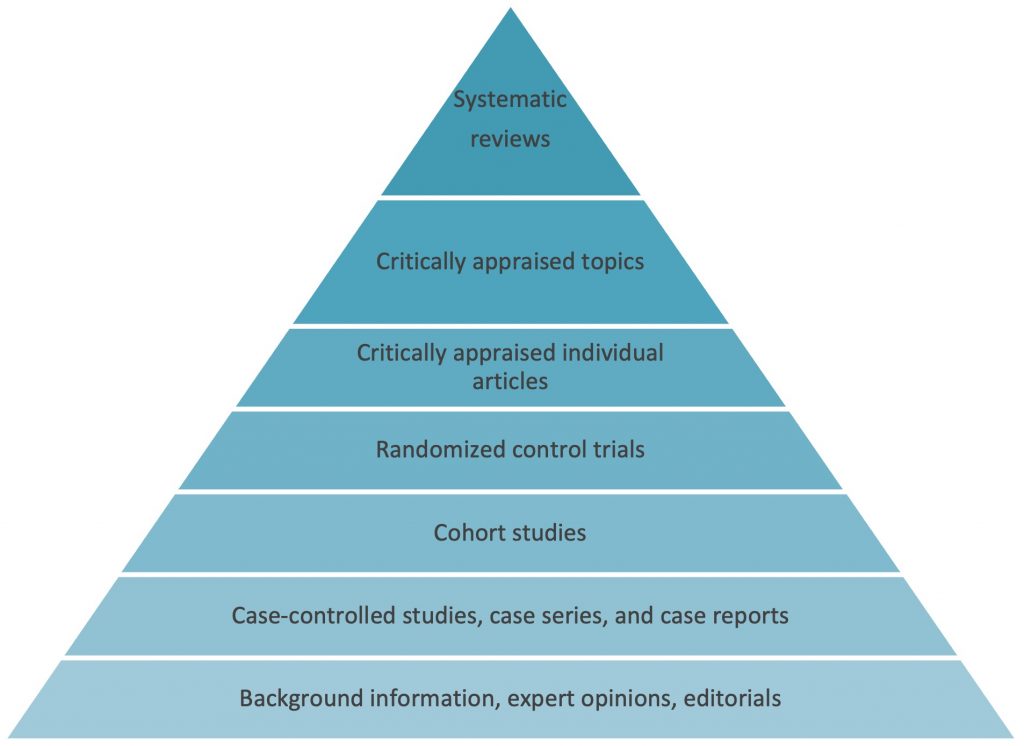Research evidence comes in various forms. The evidence pyramid is a hierarchical system of organizing and visualizing the different types of evidence.
The evidence pyramid visually shows the evidential strength of different types of research. All levels of the pyramid are “valid” evidence, but those at the higher levels are considered the most credible, for good reason.
At the very top are systematic reviews, which are scientific analyses of other scientific analysis.
What you’ll learn in this post
• What “levels of evidence” and the “hierarchy of evidence” are.
• Why certain types of evidence are seen as more valuable, but also why “lower-level” evidence can still be extremely useful.
• The evidence pyramid: a simple visual way of understanding the evidence hierarchy from bottom to top.
• Every level of evidence in detail, and its place in your research.
• Where to get expert research assistance and speed along your work to successful publication.
What is the evidence pyramid?
Evidence levels or categories were first theorized as a hierarchy in a 1979 Canadian report on health examinations. The authors developed a system of rating evidence to determine different interventions’ effectiveness and develop recommendations for periodic health exams.
The hierarchy of evidence is a key part of evidence-based medicine (EBM), a term coined in 1991. From this term developed the related idea of evidence-based practice (EBP), in which all healthcare-related decisions should be based on the best available, up-to-date, and sound evidence.
The evidence pyramid, however, generally applies to all types of research. There are specific levels of evidence in different disciplines, like education, management, or economics. But the pyramid is primarily used in medicine and clinical studies.

A systematic review or meta-analysis in less than a month? You can do it.
| Top of the pyramid | Base of the pyramid |
| Filtered literature: Secondary literature that synthesizes and evaluates the primary (lower level) literature
Includes systematic reviews, meta-analyses, and critical appraisals |
Unfiltered information: Primary literature that hasn’t been critically appraised
Includes observational research (studies comparing people receiving an intervention with those who don’t) and expert opinions |
Many scientific journals in the fields of medicine and health assign levels of evidence to studies based on their methodological quality. For example, since 2015, The Journal of Bone & Joint Surgery uses the hierarchical rating system proposed by the U.K. Centre for Evidence-Based Medicine (CEBM).
Similarly, you might be asked to do this when submitting an abstract for a conference as an author. The evidence levels might differ slightly across fields. But they always aim to help readers know how valid your study’s results are and if they’re applicable to sound decision-making.
Unfiltered or Primary Literature
We’ll start from the bottom of the evidence pyramid and work our way to the top. While the highest level is the “best” (most desirable), lower levels all have a suitable place.
You may not always find information on your topic in the filtered literature, like if you’re researching a new topic, such as the impact of a new virus on perinatal fatality rates.
Move down to the next highest level of evidence that addresses your question when this happens. Your role is to review what you find to make sure it’s methodologically sound when researching databases with unfiltered information. You’d need to consider, for example, the quality of the journal in which the study is published.
Also, watch out for the nature of the peer review process (e.g., how many reviewers are involved).
Level 7: Expert opinions, editorials
Editorials and expert opinions are at the bottom of the pyramid because they’re not necessarily backed by robust evidence. They are truthful as much as any opinion can be, and they are by experts, but they’re not always reliable for statements of fact.
Editorials
These are short articles on current issues of medical or scientific significance to the medical community or society at large. Authors aim to stimulate discussion and ideas around the development of evidence synthesis. They also try to promote sound policymaking.
Expert opinions
Among the properties of expert opinions is that they:
- Give the authors’ interpretation of the data presented in an article
- Discuss the research avenues that might emerge as we get more detailed results on the topic
- Offer a belief or conclusion held with confidence but not verified by positive knowledge or proof
Editorials and expert opinions are helpful if you’re new to a topic. They can give you general information that informs your research topic. Or they might help you identify potential keywords for your research.

However, it’s best not to take editorials and expert opinions at face value. When you’re reading one:
- Examine the author’s credentials
- Check if the sources cited (if any) are reliable and the most recent
- Check the endorsements and comments the editorial/expert opinion has received
- Check the publishing sources’ reputations
Level 6: Case-controlled studies, case series, and case reports
A case-controlled study is an observational study. Patients who already have a specific condition or disease (case group) are compared with people who don’t (control/comparison/reference group). These studies look back into time, and patient records are usually reviewed and analyzed.
For example, a 2018 case-controlled study examined the frequency of sleep disturbance in 179 patients with psoriasis compared with a control group of 105 people. Such studies require fewer resources than randomized controlled trials (Level 4) and cohort studies (Level 5), but are usually less reliable. That’s because showing a statistical relationship doesn’t mean that one factor necessarily caused the other.
For example, the case-controlled study cited above found twice as many patients with psoriasis reporting clinical insomnia compared with those from the control group. But the study does not exclude the possibility that other (social, psychological, or clinical) factors impacted the case group’s sleep patterns.
A case report is a report on the treatment and outcome of a single patient, while a case series is a collection (series) of case reports involving patients given similar treatment. They typically contain detailed information about the individual patients, such as:
- demographic information (e.g., age, gender, ethnic origin)
- information on diagnosis, treatment, response to treatment
- follow-up after treatment
These studies don’t use control groups with which to compare outcomes, so they have no statistical significance.
Level 5: Cohort studies
A cohort study works with a large population. It follows patients who have a specific condition or receive a particular treatment. And it compares them with another group that’s not affected by the condition or treatment. A cohort study’s central characteristic is its observing large numbers over a long time (usually years).
Cohort studies are beneficial if you look at a disease’s risk factors and causes. For example, you could examine whether there’s a cause and effect between non-health-related factors (e.g., women’s age or lifestyle choices, such as using oral contraceptives) and ovarian cancer.
Remember, though, that cohort studies have a high potential for bias (the tendency to influence a study’s results or interpretation). The two groups may differ in ways other than in the variable under investigation.
Level 4: Randomized control trials (RCTs)
Suppose you are a nurse practitioner wondering if you should suggest nicotine gum to help smokers quit smoking. You could look for evidence from randomized controlled trials (RCTs) to address this question.
In these rigorously planned experiments, subjects in a population (here smokers) are randomly (by chance) allocated to nicotine gum (study or intervention group) or placebo gum (control group). They are then followed up over time. Data are collected and compared with the number of participants in each group who quit smoking.
The random allocation of participants to groups and their longitudinal nature make RCTs methodologically robust. Generally, the RCT is the most rigorous design to determine whether some factor (exposure or intervention) causes an outcome, a study on evidence-based nursing suggests.

If your question is, “what will happen to this patient if we do nothing at all?”, RCTs might not be of help. This is because you’re looking at the likely course of a medical condition or disease that doesn’t involve comparing treatments. Here, the best evidence would come from a cohort study or a systematic review of cohort studies.
The 12P Method for Systematic Reviews
We’ve squeezed all the steps and stages of a typical systematic review onto one page.
You can print it out A4-sized and use it as a handy checklist, or A3-sized for your laboratory wall. You can even share it with your co-authors.
Filtered or Secondary Literature
As you move up the pyramid, however, fewer studies exist. In the rest of this article, we’ll be looking at filtered literature that follows a stringent scientific methodology to appraise the quality of studies and make practical recommendations.
Level 3: Critically appraised individual articles
A critically appraised individual article (CAIA) identifies, evaluates, and synopsizes an individual study of excellent quality that will influence a standard of practice. It’s also known as an article synopsis.
Level 2: Critically appraised topics
After a CAIA, the next best source is a critically appraised topic (CAT), also known as Evidence Synthesis. A CAT summarizes the best available research evidence on a given topic or theme so that researchers and practitioners can use it to make informed decisions. Essentially, critically appraised topics are like shorter and less rigorous systematic reviews focused on a particular topic.
Keeping up with all the new evidence from your field is daunting and practically impossible. That’s where CAIAs and CATs come into play (along with systematic reviews). They help you make evidence-based decisions in research scenarios in a time-efficient and reliable way.
Level 1: Systematic reviews
However, systematic reviews are the gold standard in exploring, collating, assessing, and summarizing the best available evidence. Their primary aim is to recommend best practices on a specific topic and inform policy.
They follow a rigorous, standardized method (a pre-determined protocol) to identify, select, and evaluate all available peer-reviewed publications on the topic (e.g., poorly conducted studies are eliminated). Essentially, all eligible research studies are viewed as a “population” to be systematically sampled and investigated.
Systematic reviews summarize results according to preselected criteria and make practice recommendations based on methodologically sound studies. This method minimizes biases and random errors and explains why systematic reviews sit at the top of the pyramid.
A systematic review may include a meta-analysis. Meta-analyses use quantitative statistical methodology to combine the results of several credible studies drawn from the literature. Because of its quantitative methods, it’s a higher-quality systematic review. Its conclusions may be used to evaluate therapeutic effectiveness, plan new studies, etc.
When to use a systematic review
Systematic reviews come in handy if you want to recommend new approaches to practice. Also, when/if there are discrepancies in how a certain practice is performed. Let’s look at a relevant example from the plastic surgery literature.
An association was hypothesized between lymphoma among women with silicone breast implants. But findings of relevant case reports and cohort studies conducted were mixed. A systematic review combined all available evidence and reached a definite conclusion: there’s no credible evidence of an increase of lymphoma originating in the breast among women with cosmetic breast implants.
As a researcher, you’ll rarely get the time to track down and peruse all primary literature related to a specific topic of interest. A systematic review is your best source of evidence if you need to quickly and accurately keep up to date with evidence accumulating in your field.
More than one study usually addresses questions about the prevention or treatment of disease and the cause or course of a disease. Suppose you need top-level evidence on the effectiveness of different health interventions in addressing specific conditions. In this case, it’s helpful to turn to a systematic review summarizing the results of randomized controlled trials.
A systematic review in a month or less? You can do it. We can help.
Our published experts ready will assist you with all steps of the systematic review and meta-analysis processes. Go here to find how you can put Edanz on your team and, if you’re in a hurry, get your work one in just a few weeks.
Or see how Edanz’s other research services can help you reach new heights.




